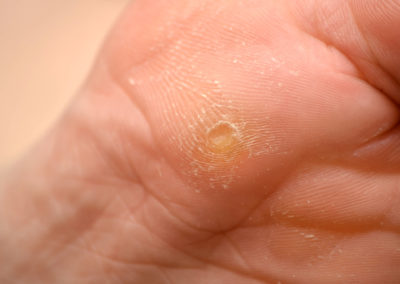Corns
What are Corns?
Corns are normally small in size and are hard circles of thick skin that typically develop in patches on the tops and sides of toes or on the sole of the foot. This is usually in response to an injury or pressure and whilst not uncommon they can become very painful.
There are 3 main types of corns:
Hard Corn
The most common type of corn which is typically hard to the touch and can be likened to the feel of a small stone in your shoe when walking. Hard round masses of yellow tinged skin, a hard corn is generally uncomfortable and painful on direct pressure.
Seed Corn
Seed Corns are very small, hard structures which look like yellow ‘seeds’ and are typically found on areas of callus under the foot, they are not usually related to direct pressure.
Soft Corns
Soft corns typically form in moist areas such as between the toes and are quite common. They appear white and rubbery and are often very sore when the toes rub against each other.
All 3 types of corns can make putting on footwear difficult and walking painful, however the good news is in most cases they can be easily removed.
What Causes Corns?
Corns can present for a number of reasons, including:
- Badly fitting footwear: shoes that are too loose can allow your foot to slide and rub, whilst shoes that are too small or narrow can cause pressure on the foot.
- High heeled shoes: certain shoe designs, like high heels, can place excessive pressure on specific areas of the foot.
- Toe deformities: deformities such as hammer toes (where the toe is bent at the middle joint) or bunions (where the joint of the big toe sticks outwards and the toe points towards the other toes on the same foot) can cause rubbing which results in corns.
Imbalanced walking: where the uneven distribution of pressure on the feet can cause corns.
What are the Treatment Options for Corns?
There are a few treatment options available to treat corns.
- Insoles and Orthotics: custom made insoles or orthotic inserts can help to treat corns following a thorough biomechanical assessment of your foot. These custom inserts fit directly into your shoes to help reduce friction, which can in turn help reduce corn formation and exacerbation. Find out more about orthotics here. There is also a whole range of foot pads, gels and supports that can be useful and advised.
- Clinical reduction: a quick and painless procedure can be carried out to reduce the corn bulk.
- Surgical treatment: in severe cases surgery can also be performed to treat the underlying cause of corns. The lesions can also be cored out under an anaesthetic.
Please note: if you are a diabetic and have developed a corn it is very important you seek treatment immediately as small wounds such as corns can sometimes develop into more serious issues. Mr. Kannegieter will be very happy to see you and devise the right treatment plan for your condition.

